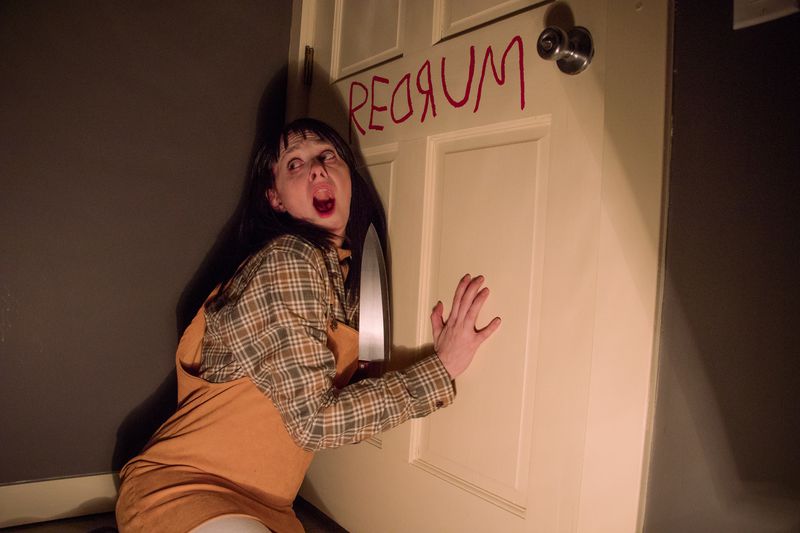Blep. Blop blop. Squee. Noises coming from your pipes that you’re suddenly attuned to, after spending weeks alone with them. You’re so lonely that going into deep conversation with your soft toys doesn’t seem so kooky anymore, and hearing your neighbor screaming “The matrix is resetting!” down the stairway is almost comforting.
The guy across the street smokes a joint at 2 p.m. every day, and you wonder why you give a shit.
As the coronavirus pandemic upends the very fabric of our existence, shutting down human interaction in one fell swoop, sanities unravel. Being confined in a tiny New York apartment, where the walls are so low there isn’t enough space to crawl up them, and realizing that butt-shaped indent on your sofa is never going away, can drive anyone stir-crazy in a snap.
This notion of isolation – being trapped in a limited space or emptiness, alone or in a group, while something sinister lurks around and is getting ready to rip you to pieces – is petrifying and has been the driving terror element in many horror movies. Immersing oneself in their plots and underlying psychological themes, as a lens to further understand what we are going through today, reveals many insights and parallels.
A poignant example is how Stephen King was inspired to write The Shining after spending a fitful night as the only guest of a hotel, where he dreamed of his son screaming and running down the long, empty corridors. King had the main character, Jack Torrance, drowning in desolation as he, his wife and kid holed up in an unoccupied mountain hotel in Colorado.
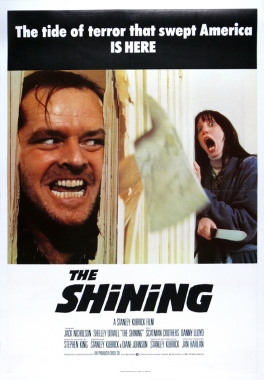
Theatrical poster for The Shining (1980).
In the 1980 movie, Jack (played by Jack Nicholson) slid off the deep end, and one wonders if seeing ghostly bartenders and the desire to kill his family came from the haunted influence of the hotel or the sheer grimness of being in solitude without anyone around for miles.
Seeing a perfectly sane man slowly lose it, typing an endless stream of “all work and no play makes Jack a dull boy”, paints a dire image of our (possible) future. And parents beware: it wasn’t just Nicholson’s character who descended into the madness. The kid starts seeing little girls covered in blood, and writes “redrum” (murder, backwards) on mirrors.
The cult horror classic – that evokes an image of a deranged Nicholson poking his face through a hacked door – is the quintessential point of reference for going bonkers from cabin fever. It is Stanley Kubrick at his best – the jump cuts are supremely mordant, but the most terrifying moments are when nothing is happening – like when Jack stares intently at the hedge maze. Even in the opening scene, as the Torrances drive up the Rockies to the hotel, against the off-kilter music, the very tangible premonition of loneliness sends chills up your spine.
It’s no surprise Twitter and Instagram feeds are now chock full of memes with the film’s tag line: “A couple of weeks of isolation with the family. What can go wrong?” When the movie was released 40 years ago, the New York Times commented in its review that The Shining chillingly depicts a “brilliantly staged, vicious version of a household spat,” in the throes of isolation – unnervingly close to home.
With a mad axe-murderer nipping at your heels, it would be awesome to be as badass as Sigourney Weaver in Alien, a 1979 sci-fi-slash-horror classic. A crew of astronauts are stuck on a commercial space tug for two years. When they finally get off the ship on an uncharted planet, Kane, played by John Hurt, gets ferociously attacked and infected by a facehugger – a critter that wraps itself around his face. He almost suffocates (cough) and a monster bursts out of his chest a few hours later.
Sounds familiar? It gets worse. The predatory alien now loose on the ship turns out to be a lethal beast, and it picks off the crew one by one. The last one standing is Weaver’s fearless character, Ripley; clad in a boiler suit and armed with a machine gun, she makes it to the escape pod and ends up drifting around space, alone, for 57 years.
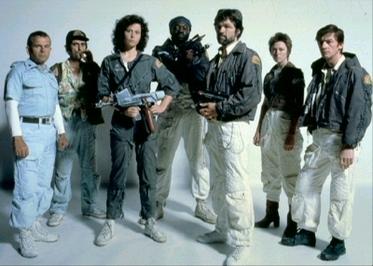
Promotional photo of the main cast of the 1979 film Alien. Left to right: Ian Holm as Ash, Harry Dean Stanton as Brett, Sigourney Weaver as Ripley, Yaphet Kotto as Parker, Tom Skerritt as Dallas, Veronica Cartwright as Lambert, and John Hurt as Kane.
Every nuance of tightness that Ridley Scott put into the movie – the constantly closing doors, Tom Skerritt’s character crawling through pitch black tunnels in the ship’s bowels, the smothering facehugger – create a palpable foreboding of claustrophobia. It’s a fear we all face now: that the space you live in, day in and day out, will constantly constrict until it eats you up.
The film’s original poster read: “In space no one can hear you scream”, underscoring that the true horror of the premise is not just the alien on board, but that Ripley, towards the last quarter of the movie, had to fight it off and survive alone. A cue for all singletons: if Ripley had the balls to stand against a gruesome killer twice her size and remain sane until the end, so can we.
What if the alien was invasive in a different (and now familiar) way – a disease that didn’t have obvious symptoms until it’s too late? In John Carpenter’s The Thing, a bunch of scientists at a remote outpost in Antarctica are trapped with a parasitic alien that replicates the appearance of its victims. The constant struggle is not knowing who amongst them are “the thing”, and not being able to leave or call for help because they are so far out of radio coverage.
The senior officer, played by Kurt Russell, weeds out the aliens from the humans in ways that feel eerily relevant right now: blood tests, and quarantining those who were exposed to the alien when it burst out of a dog and turned into a freaky Lovecraftian abomination. The outpost devolves into a paranoid mess, as the men try to figure out their chances of being infected.
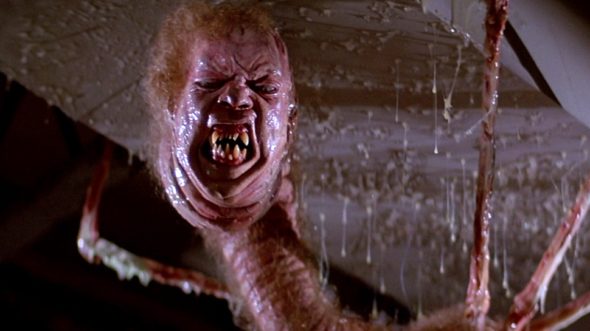
The Thing of “The Thing”.
The plot was well ahead of its time, foretelling the future – an imperceptible microbe chipping away at our humanity at the most microscopic level. The real terror is the darkness that overcomes the men after the monster arrives, realizing they are stuck with it. The core difference between now and the movie? That parasite never made it out of Antarctica.
The Thing was destroyed by critics when it released in 1982, mainly due to the excessive gore and because there was no happy ending. But in the following decades it became a pop culture hit with a massive fan base, setting the bar for all future sci-fi monster flicks. Maybe now, it’ll garner even more fans and stay on Netflix’s top 10 list for a long, long time.
While all these movies ultimately end in at least one of the gang surviving, imagine a scenario where no one makes it out alive. Another sleeper hit, Moon from 2009, depicts an astronaut (Sam Rockwell) on an oil mining base on the dark side of the Moon. Alone in crushing solitude, Rockwell’s character, Sam, eagerly waits for his three year tenure to be up so he can return to the Earth and be with his family.
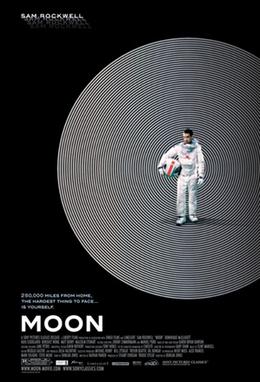
The Moon’s theatrical poster.
Sam soon discovers there is no going home. The twist is magnificent: he finds dead clones of himself in an abandoned mining helium, and new shiny ones aboard the ship. As it turns out, in an age of capitalism where everything is optimized for maximum efficiency, instead of having to spend millions sending an astronaut to the Moon every three years, NASA packed a truckload of clones onto one ship; a clone dies every three years, and is replaced by a new one.
Why three years and not a lifetime? Because research says three years alone on the Moon is all that a man can take before he goes berserk. On the surface, the thematic comparison to present times is the banality and anxiety of isolation, but digging deeper, there is a nod to the role that profit-making plays in our healthcare infrastructure; a system that fails the working class, now all the more exposed with the coronavirus outbreak.
It also plays into what scientists quoted by The Guardian say about the coronavirus – that it will go away, but may come back every fall, so there is no such thing as getting rid of it. When will self-isolation truly end? Will it become the norm until a vaccine is found? Will the coronavirus ultimately halt international travel, separating families and loved ones, for another… three years?
The ultimate question is what do we do, faced with a future filled with more draconian isolation and death. In Don Hertzfeldt’s Oscar-nominated, 2015 animated sci-fi short, World of Tomorrow, a young girl named Emily is visited by a clone of herself from 227 years in the future. They revisit the girl’s past, and the clone tells her that in 60 days, the earth will be destroyed by a meteorite. The clone takes a memory of Emily and her mother for safekeeping, and tells her:
Do not lose time on daily trivialities. Do not dwell on petty detail. For all of these things melt away and drift apart within the obscure traffic of time. Live well and live broadly. You are alive and living now. Now is the envy of all of the dead.
If there is one takeaway from these movies, it is to not allow the loneliness to get the better of you. Be grateful we are healthy and alive. Ergo, don’t watch any of the movies mentioned here until the lockdown is over – keep those sentiments of doom and gloom for better times.
Shantila Lee is a graduate student in the Magazine and Digital Storytelling Program
